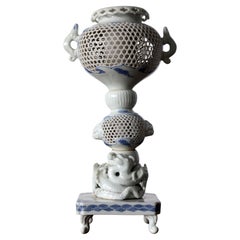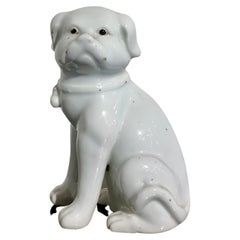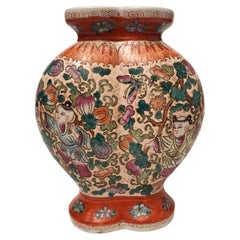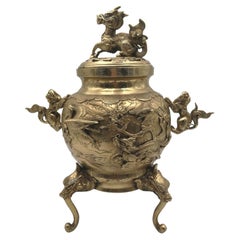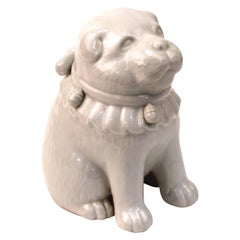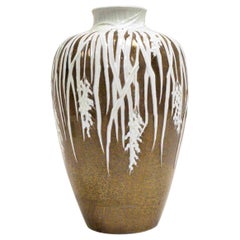Hirado Furniture
to
1
2
2
2
2
2
2
2
2
2
2
1
11,710
3,898
2,415
2,232
Creator: Hirado
Hirado Porcelain Koro Censer Meiji Dynasty
By Hirado
Located in Mérida, YU
This is an original Japanese Antique Porcelain Hirado Koro Censer circa 1850-1890 Meiji Dynasty.
In excelent condition.
Category
Late 19th Century Japanese Japonisme Antique Hirado Furniture
Materials
Porcelain
Japanese White Glazed Hirado Ware Puppy, Edo/Meiji Period, Mid 19th Century
By Hirado
Located in Austin, TX
An absolutely adorable Japanese Hirado Mikawachi ware white glazed porcelain model of a puppy dog, Edo to Meiji period, early to mid 19th century, Japan.
The cute puppy is portray...
Category
Mid-19th Century Japanese Meiji Antique Hirado Furniture
Materials
Porcelain
Related Items
Qing Ching Dynasty 1821-1850 Porcelain Enamel Double Mouth Chinese Vase
Located in Louisville, KY
This stunningly enameled porcelain vase has a double mouth opening with hand-painted images of boys playing among the vines, gourds and gourd blossoms. There is a border of bat-like ...
Category
Early 19th Century Chinese Qing Antique Hirado Furniture
Materials
Porcelain
$1,100
H 12.25 in W 9 in D 5 in
Japanese bronze Koro
Located in Beuzevillette, FR
Impressive handmade large and powerfully cast Japanese tripod bronze censer of the 19th century, made during the Meiji period and with mythical animals...
Category
19th Century Japanese Antique Hirado Furniture
Materials
Brass
Antique Qing Dynasty Blue and White Chinese Porcelain Censer
Located in Brea, CA
Qing dynasty Kang XI blue and white Chinese porcelain censer with a design of "Antiques" and auspicious objects, the base in clear glaze and the mouth...
Category
Early 18th Century Chinese Qing Antique Hirado Furniture
Materials
Porcelain
Large Japanese Meiji Period Imari Vase, 19th Century
Located in San Francisco, CA
A large and impressive fine quality 19th century Imari vase, with hand painted classical floral motif and inset panels painting of playful Foo Dogs.
Japan, Meiji period, late 19th c...
Category
Late 19th Century Japanese Meiji Antique Hirado Furniture
Materials
Porcelain
Antique Japanese Bronze Koro (Incense Burner)
Located in Pomona, CA
Japanese bronze Koro (Incense Burner) in the form of two kids playing drum. This Koro was hand crafted in about early 20th Century with removable top. It has There is a Tai Chi Diagr...
Category
Early 20th Century Japanese Anglo-Japanese Hirado Furniture
Materials
Bronze
Antique Meiji 19th C Japanese Jubako Ikegawa Ware Tea Ceremony Box Japan
Located in Amsterdam, Noord Holland
Description
A lovely piece
Condition
Perfect. 20x13x13cm
Period
19th century Meiji Periode (1867-1912)
Category
19th Century Japanese Meiji Antique Hirado Furniture
Materials
Porcelain
$1,164
H 7.88 in W 5.12 in D 5.12 in
Qingbai Lotus Censer, Song Dynasty
Located in seoul, KR
This exquisite Qingbai piece, acquired in Hong Kong in the late 1990s, is a high-quality artifact from the Southern Song Dynasty, likely produced at the Hutian Kiln. The base exhibit...
Category
15th Century and Earlier Hong Kong Antique Hirado Furniture
Materials
Ceramic
Antique Meiji 19th C Japanese Jubako Ikegawa Ware Tea Ceremony Box Japan
Located in Amsterdam, Noord Holland
Description
A lovely Jubako piece
Condition
Perfect. 13x12.5x12.5cm
Period
19th century Meiji Periode (1867-1912)
Category
19th Century Japanese Meiji Antique Hirado Furniture
Materials
Porcelain
$439
H 5.12 in W 4.93 in D 4.93 in
A Zhejiang Porcelain Ewer, Northern Song Dynasty
Located in seoul, KR
The oviform body is divided into few lobes. All covered in a finely crackled pale olive-green glaze. The surface and glaze characteristics are definitive, confirming the authenticity...
Category
15th Century and Earlier Hong Kong Antique Hirado Furniture
Materials
Porcelain
EXQUISITE ANTIQUE CHINESE COPPER & SiLVER CABOCHON LID MEIJI DYNASTY DRAGON POT
Located in West Sussex, Pulborough
Royal House Antiques
Royal House Antiques is delighted to offer for sale this absolutely exquisite Meiji Dynasty Copper pot with Silver dragons and Cabochons to the top
A very good...
Category
20th Century Chinese Chinese Export Hirado Furniture
Materials
Silver, Copper
$664
H 4.73 in Dm 3.94 in
JAPAN IMPERIAL 1900 Meiji Period Tripode Koro Censer In Cloisonné Enamel With
Located in Miami, FL
Japanese tripod Koro from the Meiji Period (1868-1912).
This is a rare and beautiful antique koro censer, created in the imperial Japan during the Meiji period (1868-1912), circa 1900. It was carefully crafted in solid bronze and copper with silver wires and embellished with applications of polychromatic Cloisonné enamels and aventurine. The designs depict organics and natural motifs such mythological animals and flowers.
The Chrysanthemum Symbol
In Imperial Japan, the chrysanthemum (Kiku) was a potent symbol of the imperial family and the emperor himself, representing longevity, royalty, and divine power. The 16-petaled chrysanthemum is the Imperial Seal and crest, found on passports, coins, and the Chrysanthemum Throne. This association dates back to the Kamakura period (1185–1333), particularly with Emperor Go-Toba's fondness for the flower, establishing its link to imperial authority and lineage. The connection between the chrysanthemum and the imperial family began when Emperor Go-Toba adopted it as a personal emblem, aligning it with the strength and refinement of the emperor's rule. During the Meiji Period, the 16-petaled chrysanthemum crest, solidifying the association with the imperial family, was established during this time.
The Meiji Imperial Period
This is an era of Japanese history that extended from October 23, 1868 to July 30, 1912.The Meiji era was the first half of the Empire of Japan, when the Japanese people moved from being an isolated feudal society at risk of colonization by Western powers to the new paradigm of a modern, industrialized nation state and emergent great power, influenced by Western scientific, technological, philosophical, political, legal, and aesthetic ideas. As a result of such wholesale adoption of radically different ideas, the changes to Japan were profound, and affected its social structure, internal politics, economy, military, and foreign relations. The period corresponded to the reign of Emperor Meiji. It was preceded by the Keiō era and was succeeded by the Taishō era, upon the accession of Emperor Taishō.
Country: Imperial Japan.
Period: Meiji, 1890-1910.
Technique: Silver Wire Cloisonné over copper and bronze.
Weight: 416.80 Grams, (0.417 Kg).
Measurements:118 mm by 115 mm (4.65 x 4.52 Inches).
Koro
This term refers to a Japanese censer, incense burner, perfume burner or pastille burner is a vessel made for burning incense or perfume in some solid form. They vary greatly in size, form, and material of construction, and have been in use since ancient times throughout the world. They may consist of simple earthenware bowls or fire pots to intricately carved silver or gold vessels, small tabletop objects a few centimeters tall to as many as several meters high. Many designs use openwork to allow a flow of air. In many cultures, burning incense has spiritual and religious connotations, and this influences the design and decoration of the censer.
Cloisonné
This is an enameling technique in which the pattern is formed by wires soldered to the surface of the object to be decorated, which is usually made from copper, forming cells or cloisons, each of which holds a single colour of enamel paste which is then fired, and ground and polished. The champleve technique also uses an enameling technique, but the cells are formed by carving into the surface of the object, or in the casting. The cloisonne technique has been in use since the 12th century BC in the west, but the technique did not reach China until the 13th or 14th century. It became popular in China in the 18th century. Initially bronze or brass bodies were used, and in the 19th century copper, at which time the quality of the items produced began to decline. Chinese cloisonné is the best-known enamel cloisonné, though the Japanese produced large quantities from the mid-19th century, of very high technical quality. In the west the cloisonne technique was revived in the mid-19th century following imports from China, and its use continued in the Art Nouveau and Art Deco periods.
Condition: Basically, is in great antique condition, near mint, with insignificant and minimal usage, in great condition. All parts are secured in the settings. This Japanese Meiji Koro...
Category
Early 1900s Japanese Meiji Antique Hirado Furniture
Materials
Silver, Bronze, Copper, Enamel
$1,398 Sale Price
30% Off
H 4.65 in Dm 4.52 in
Qing Dynasty A Antique Chinese Porcelain Gu Vase
Located in Brea, CA
Qing Dynasty an antique 19th century Chinese porcelain Gu vase decorated with shuangxi, the Measures: 9.25'' diameter x 16'' high.
Category
Early 20th Century Chinese Qing Hirado Furniture
Materials
Porcelain
Previously Available Items
Hirado Japanese Porcelain Puppy Dog
By Hirado
Located in Astoria, NY
Japanese Meiji period glazed porcelain figure of a puppy dog, made by Hirado Porcelain. The puppy is wearing a collar with bells. Likely made in circa...
Category
1890s Japanese Meiji Antique Hirado Furniture
Materials
Porcelain
Large Historical Presentation Porcelain Vase Meiji
By Hirado
Located in Atlanta, GA
A large stunning Japanese porcelain vase with a historical background. It was a presentation piece from the city of Sasebo (located in Kyushu, Japan) to Samejima Kazunori (1845-1910), an admiral of the early Imperial Japanese Navy, in the February of Meiji 39 year (1906). The vase is of the highest quality and beauty. On the subtly overglazed gold painted background, the upper body of the vase is draped with molded relief of hanging orchids. The realistic rendering of the leaves and blossom is extremely impressive in its naturalistic details, showcasing a superb workmanship. The base is fully marked with the presentation details and dates. A previous drilled hole can be professional restored. A stunning piece with a historical interest.
The vase is identified as likely made by Koransha, Scented Orchid Company. It was established in1875 by Ezaiemon Fukagawa (1833-1889), Fukaumi Suminosuke and his brother Takeji, Tsuji Katsuzo and Tezuka Kamenosuke, which produced fine porcelain. In 1879, Fukaumi and other members left the company and Koransha was reestablished by Eizaemon alone. After his death in 1889, his oldest son, Yotaro succeeded the Koransha company while his second son, Fukagawa Chuji started the Fukagawa Porcelain Company. The company is located in Arita which had some historical ties with Hirado kilns. It acquired the assets of the Hirado Mikawachi kilns in the beginning of the 20th century. Some productions naturally merged in the process. The vase was presumably made during that time.
Hirado ware...
Category
Early 1900s Japanese Japonisme Antique Hirado Furniture
Materials
Porcelain
Hirado furniture for sale on 1stDibs.
Hirado furniture are available for sale on 1stDibs. These distinctive items are frequently made of porcelain and are designed with extraordinary care. There are many options to choose from in our collection of Hirado furniture, although gray editions of this piece are particularly popular. If you’re looking for additional options, many customers also consider furniture by Kutani Studio, Makuzu Kozan, and Fukagawa. Prices for Hirado furniture can differ depending upon size, time period and other attributes — on 1stDibs, these items begin at $1,800 and can go as high as $3,200, while a piece like these, on average, fetch $2,813.
Creators Similar to Hirado
Questions About Hirado Furniture
- What is Hirado?1 Answer1stDibs ExpertApril 5, 2022What Hirado is depends on the context. Hirado is a city in Nagasaki, Japan, well known for producing white and blue porcelain. You will sometimes see the pieces produced in the region called Hirado or Hirado ware. On 1stDibs, find a variety of Hirado ware.
- What is Hirado porcelain?1 Answer1stDibs ExpertApril 5, 2022Hirado porcelain or Hirado ware is made in Japan. Most often it’s made in Makawachi so you will hear it referred to as Mikawachi ware at times. A sometsuke underglaze of cobalt and white is most popular as it highlights the fine grain of the porcelain and the complicated details and elaborate openwork. Shop a collection of Hirado ware from some of the world’s top sellers on 1stDibs.
